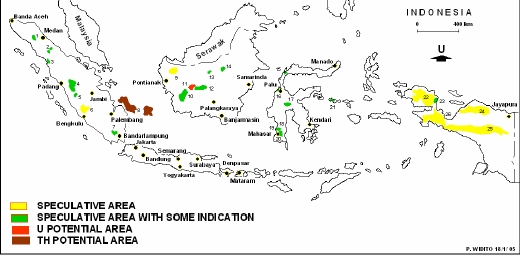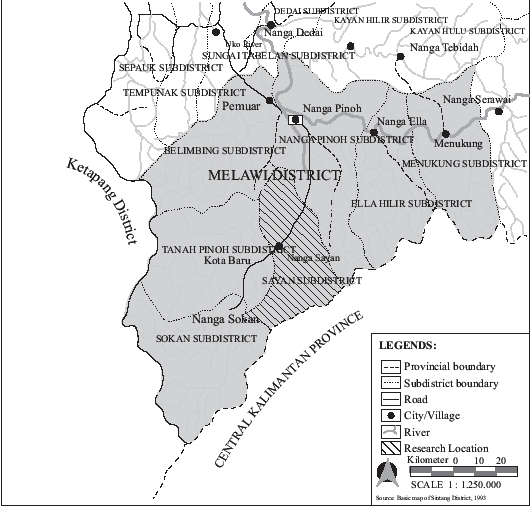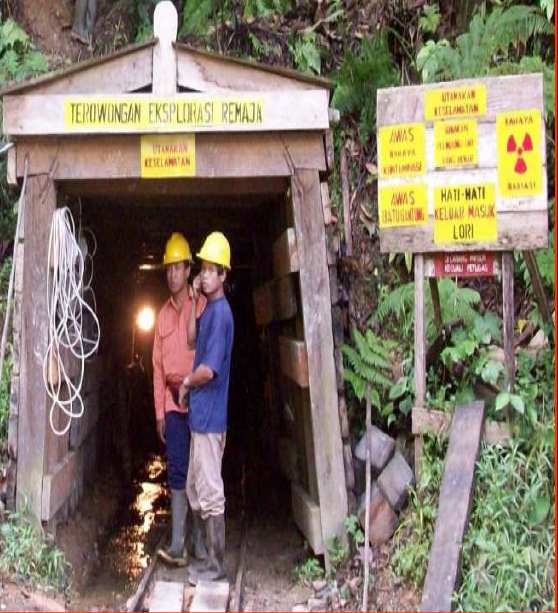Uranium mining
Introduction
While potential uranium and thorium ore loads are widely distributed in Indonesia, there are two established uranium ore lodes, possibly inactive, at Remaja-Hitam (aka Edo-Remaja) and Rirang-Tanah Merah, located near Desa Kalan, Kecamatan Ella Hilir, Melawai, Kalimantan Barat.
Analysis
Expert: Indonesia Uranium Reserves Are Too Little to be Extracted, Tempo Interactive, 2010-02-11
Nuclear expert Iwan kurniawan said uranium reserves in Indonesia, which is buried in West Kalimantan, are “economically infeasible (to be extracted), and there will more materials that should be exhumed from the earth.” Iwan said the thickness of uranium reserves in the country was only around half a meter, far less than those buried in Pakistan which could have thickness of around two meters. Furthermore Iwan said there is no guarantee that Indonesia could obtain a license to enrich uranium and the condition will only make Indonesia be controlled by uranium supplying countries. The remarks challenged statement from former president B.J. Habibie made last week in which he said nulear energy as one suitable solution.
TEMPO InteractiveWest Kalimantan Mulls Nuclear Power To Generate Electricity, Nashir Mansor, Barnama, 28 January 2010
West Kalimantan has ample uranium reserves which can be enriched to produce electricity, Deputy Governor Drs Christiandy Sanjaya says. He said this possibility was prompted by the electricity crisis faced not only by West Kalimantan but all four provinces in the Indonesian portion of Borneo. The use of nuclear energy in electricity generation was cheaper compared with other methods and since Kalimantan was situated outside earthquake zones, it would be suitable, he said.
Legislators support study on uranium potentials in W Kalimantan, Antara, 8 November 2006
Indonesian House of Representatives` Commission VII expressed support here on Friday to the National Nuclear Power Agency`s (Batan) plan to continue studying the potential of uranium reserve in the West Kalimantan village of Kallan in the district of Melawi. “We have already been determined to “go nuclear” in 2016 and therefore the spirit has to be maintained consistently. The country must not rely upon other countries for the raw materials for producing the strategic primary energy source as reliance will only make the country dependent,” a member of the commission that deals with energy affairs, Tjatur Sapto Edy, said to ANTARA News. He admitted that uranium as a raw material for producing energy was not yet economical but he believed it would continue to be in the future. He said “Indonesia needs accurate data about uranium potentials in Melawi and the National Atomic Energy Agency has to study them. I am convinced uranium mining will be feasible by 2016.”
The agency`s deputy for nuclear basic technology development, Karyono HS, said that the agency was still on a stage of exploring for the purpose of research and development. “Exploitation is possible but it will need a lot of money. The agency has so far only had time not funds,” he said.
Countries of Strategic Nuclear Concern: Indonesia, Carolyn Taylor, Yana Feldman, Charles Mahaffey, Brett Marvin, Jack Boureston, SIPRI, 2004.
It appears that Indonesia has two established mines, both in the West Kalimantan uranium district. The first, Remaja-Hitam Ore Body is a uranium vein in fine grained metamorphous rock and is thought to contain between 5000 and 10000 tons of uranium with a grade range of between 0.10 and 0.30. Also, known as the Edo-Remaja prospect, this reserve is reportedly capable of providing Indonesia with a supply of yellowcake sufficient to meet domestic needs for planned reactors. The second mine, Rirang-Tanah Merah Ore Body is also a uranium vein in fine grained metamorphous rock, though it is thought to contain less than 500 tons U and have a grade range of between 0.30 and 1.00. While it is estimated that Indonesia can produce about 770 tons of uranium per year, the aforementioned mines are currently thought to be dormant. Should it prove economically viable or politically necessary, Indonesia can probably mine enough uranium from its domestic reserves to provide yellowcake for its planned nuclear power reactors.
2007 Survey of Energy Resources: Uranium – Indonesia, World Energy Council 2007.
The Nuclear Minerals Development Centre of the Indonesian National Atomic Energy Agency (BATAN) began exploring for uranium in the 1960s. Since 1996, exploratory work has tended to focus on the vicinity of Kalan in West Kalimantan. Exploration drilling has continued in recent years in a number of locations. No production of uranium has yet taken place. At the beginning of 2005, Indonesia’s RAR [Reasonably Assured Resources], on an in-situ basis and recoverable at less than US$ 130/kgU, amounted to 6,797 tonnes, of which about 7% fell within the less than US$ 80 bracket; Inferred Resources [IR] (at up to US$ 130) were 1,699 tonnes, in situ. For both RAR and IR, an estimated 68% was considered to be recoverable. Over and above these amounts, SR [Speculative Resources] were put at 12 481 tonnes.
Determination of Quality, Quantity, and Geometry of Uranium Deposit at North Tanah Merah, Kalan, West Kalimantan, Lilik Subiantoro, Widiyanta dan P. Widito, Seminar Geologi Nuklir Dan Sumberdaya Tambang Th 2004, Pusat Pengembangan Geologi Nuklir – BATAN, Database Riset Iptek.
The research based on 1997/1998 the systematic prospection result which was discovered a uranium mineralization zones indication with in the area of 11,733 m2 at Tanah Merah. That mineralization were found with in favourable rock of quartzite that intruded by granitic rock. Uranium minerals are uraninite and brannerite, fill in spotes and incontinously WNW-ESE fractures. The aim of this research was to find information about sub surfaces uranium geology characteristic, geometric, and U resources available at North Tanah Merah using shallow geological exploration drilling. The result of drilling at 3 location arising 60 m depth each, have found some uranium mineralization indications that was identified as in uranium ore lensis. The geometry of the lensis is 5 cm-3 m length, 15 cm maximum wide and 5-150 thick. The result of U reserve estimation around 3 drill holes with in 5.064 m2 area and at 66 m depth, is contain 31.348 tons U with in inferred category.
Prancis Mengeruk Uranium Melawi? Liputan6.com, 16 July 2006.
Desa Kalan adalah salah satu dari enam titik wilayah yang menyimpan kandungan uranium. Lokasi eksplorasi uranium bisa dicapai melalui jalan sepanjang sekitar 22 kilometer dengan medan yang berat. Di tempat itu terdapat Pos Keamanan Batan yang menjaga lokasi penambangan bahan pembuat bom nuklir itu. Bersama dua mantan karyawan Komisariat Energi Atom Prancis (CEA) dan beberapa petugas Batan, Tim Sigi SCTV menelusuri pengeboran di Desa Kalan. Setelah mendaki hampir dua jam, tim tiba di mulut terowongan. Goa sepanjang kurang lebih 600 meter ini dibangun untuk menghubungkan titik-titik pengeboran uranium. Di sekitar terowongan, sesekali didapati batu sampel uranium yang tertutup alang-alang. Menurut mantan ahli geologi CEA Said Marjan, sampel batu tersebut berkadar uranium rendah. Sementara yang berkadar uranium tinggi sudah raib sekitar 30 tahun silam. Nanga Kalan dan sekitarnya hanyalah bagian kecil dari proyek raksasa eksplorasi dan eksploitasi uranium di Kalimantan. Dari luas wilayah 175 ribu kilometer persegi yang diteliti, 39 ribu kilometer persegi terbukti mengandung uranium sebesar 24.112 ton uranium. Ratusan ton di antaranya telah diboyong ke luar negeri.
Indonesia telah kecolongan uranium. Kesadaran yang seolah terlambat datang itu kini ramai dilantangkan para tokoh masyarakat Melawi. Eksplorasi uranium di hutan Nanga Pino, Nanga Elah, dan Nanga Kalan dilakukan selama delapan tahun sejak 1969. Eksplorasi dilakukan oleh perusahaan Prancis yang tergabung dalam CEA dengan berkerja sama dengan Batan. Menurut Ketua DPRD Melawi Sukirman, ekplorasi uranium di wilayahnya menjadi sebuah proyek yang sangat misterius. “Sampai sekarang kita tak bisa ikut mengakses ataupun memahami apa kegiatan itu,” jelas Sukirman. Sejauh ini, pihaknya hanya mengetahui penambangan itu untuk penelitian.
Project coordinator: Richard Tanter
Updated: 26 November 2015




